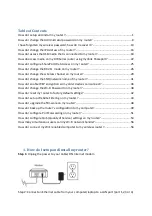
Client Quality of Service
Class Map
Cisco Small Business WAP551 and WAP561 Wireless-N Access Point
122
7
•
Destination MAC Address—Select this field and enter the destination MAC address to
compare against an Ethernet frame.
•
Destination MAC Mask—Enter the destination MAC address mask to specify which
bits in the destination MAC to compare against an Ethernet frame.
For each bit position in the MAC mask, a 0 indicates that the corresponding address bit
is significant and a 1 indicates that the address bit is ignored. For example, to check only
the first four octets of a MAC address, a MAC mask of 00:00:00:00:ff:ff is used. A
MAC mask of 00:00:00:00:00:00 checks all address bits and is used to match a single
MAC address.
•
VLAN ID—Select this field and enter the specific VLAN ID to compare against an
Ethernet frame.
This field is located in the first/only 802.1Q VLAN tag.
STEP 5
Click Save. The changes are saved to the Startup Configuration.
NOTE
To delete an ACL, ensure that it is selected in the ACL Name-ACL Type list, select Delete ACL,
and click Save.
Class Map
The Client QoS feature contains Differentiated Services (DiffServ) support that allows traffic
to be classified into streams and given a certain QoS treatment in accordance with defined per-
hop behaviors.
Standard IP-based networks are designed to provide best-effort data delivery service. Best-
effort service implies that the network delivers the data in a timely fashion, although there is
no guarantee that it will. During times of congestion, packets may be delayed, sent
sporadically, or dropped. For typical Internet applications, such as email and file transfer, a
slight degradation in service is acceptable and in many cases unnoticeable. However, on
applications with strict timing requirements, such as voice or multimedia, any degradation of
service has undesirable effects.
A DiffServ configuration begins with defining class maps, which classify traffic according to
their IP protocol and other criteria. Each class map can then be associated with a policy map,
which defines how to handle the traffic class. Classes that include time-sensitive traffic can be
assigned to policy maps that give precedence over other traffic.
You can use the Class Map page to define classes of traffic. Use the Policy Map page to define
policies and associate class maps to them.
















































